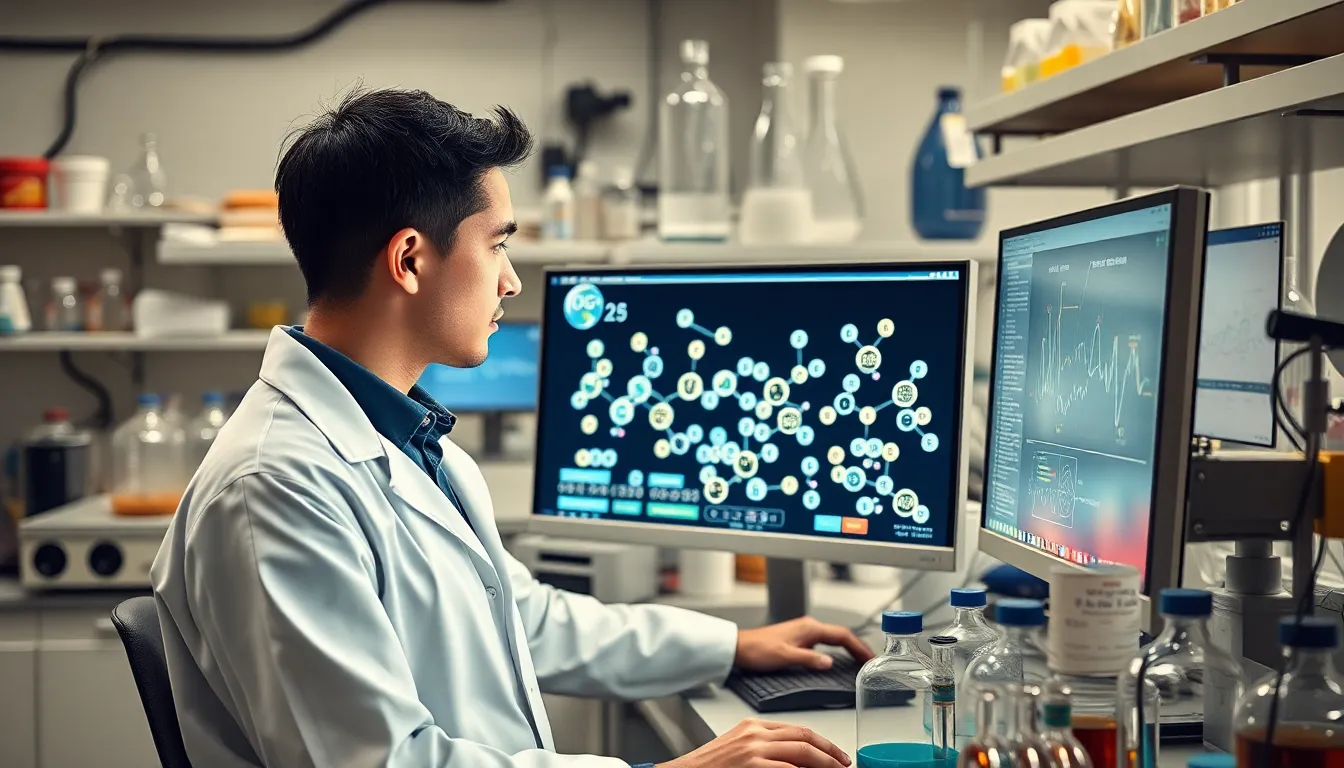In the fast-paced world of pharmaceuticals, the quest for groundbreaking drugs often feels like searching for a needle in a haystack. Enter machine learning, the superhero of data analysis, swooping in to save the day. By crunching mountains of data faster than a caffeine-fueled intern, machine learning algorithms can identify potential drug candidates that humans might overlook.
Table of Contents
ToggleOverview Of Machine Learning In Drug Discovery
Machine learning transforms drug discovery by streamlining processes and enhancing precision. Analysts primarily utilize algorithms to process extensive datasets, making it easier to identify connections between chemical compounds and biological targets. These algorithms excel at recognizing patterns that may not be apparent to human researchers.
Data-driven methodologies play a crucial role in predictive modeling. Researchers develop models to predict a compound’s efficacy or toxicity based on historical data. Such predictive capabilities significantly accelerate the initial stages of drug development.
With machine learning, screening techniques see substantial improvements. Traditional high-throughput screening is often time-consuming and costly. Machine learning can prioritize compounds that show greater promise, thus reducing time and resources required in the early stages.
Collaboration is essential in enhancing machine learning models. Experts in chemistry, biology, and computer science work together to refine these algorithms, increasing their accuracy. This interdisciplinary approach fosters innovation and leads to the discovery of novel drug candidates.
Real-world applications showcase the efficacy of machine learning in drug discovery. For instance, companies like Atomwise utilize deep learning algorithms to predict interactions between drugs and protein structures. Their models have already identified potential candidates for diseases such as Ebola and multiple sclerosis.
Challenges remain in this rapidly evolving field. Data quality and quantity often impact the performance of machine learning models. However, continued advancements promise to address these issues and refine the drug discovery process further.
Key Applications

Machine learning significantly enhances drug discovery processes through various applications. These technologies empower researchers to identify targets, screen compounds, and model predictions efficiently.
Target Identification
Machine learning algorithms excel at target identification by analyzing biological data. They uncover relationships between proteins and diseases that might remain hidden through traditional methods. Using large datasets, these algorithms prioritize targets based on factors like relevance and potential impact. Researchers streamline the process, making it faster to pinpoint viable drug targets. For instance, advancements in genomic data analysis allow for rapid assessment of genes associated with specific conditions.
Compound Screening
Speed and efficiency define the compound screening process utilizing machine learning. Algorithms process extensive chemical libraries, identifying compounds that likely interact with biological targets. By employing strategies like virtual screening, researchers minimize the resources needed for testing. Promising candidates rise to the top, allowing scientists to focus on the most viable options. Furthermore, real-time data assessment enhances decision-making, leading to quicker insights into a compound’s potential.
Predictive Modeling
Predictive modeling transforms drug development by forecasting compound characteristics. Machine learning analyzes historical data, enabling accurate predictions of efficacy and toxicity. These models help scientists prioritize compounds based on their likelihood of success in clinical phases. By refining predictions through iterative training, researchers can adapt to new data efficiently. Companies employing these models see accelerated timelines from discovery to clinical trials, maximizing research investments.
Benefits Of Machine Learning In Drug Discovery
Machine learning significantly enhances the drug discovery process through various benefits, driving efficiency, accuracy, and cost savings.
Increased Efficiency
Data analysis occurs at an unprecedented speed with machine learning algorithms. Researchers identify potential drug candidates quickly, minimizing time spent on exhaustive searches. Early-stage development processes streamline as algorithms prioritize compounds for further study. Researchers focus on high-potential candidates instead of sifting through irrelevant options. Automation also facilitates routine tasks, freeing up human experts to concentrate on complex decision-making. Overall, the speed and effectiveness of these techniques vastly improve research timelines.
Enhanced Accuracy
Machine learning algorithms excel in identifying complex relationships within large datasets. Patterns that human researchers might overlook become apparent through intensive analysis. Enhanced predictive capabilities allow researchers to anticipate the efficacy or toxicity of compounds more accurately. Machine learning’s rigorous data-driven methodologies elevate the precision with which scientists can identify viable drug targets. Improved accuracy in screening increases the likelihood of successful outcomes in clinical trials, promoting better investment and resource allocation.
Cost Reduction
Substantial cost savings result from implementing machine learning in the drug discovery process. By focusing on the most promising candidates, companies reduce the financial burden of extensive research and development efforts. Fewer resources expend on unpromising leads translate into lower overall project expenses. Identifying successful candidates earlier also leads to quicker market entry, maximizing potential revenue. Ultimately, the integration of machine learning enhances cost efficiency, enabling pharmaceutical companies to allocate funds more strategically.
Challenges And Limitations
Machine learning in drug discovery faces several challenges that can hinder its effectiveness. Key issues include data quality and model interpretability.
Data Quality Issues
Data quality directly impacts the success of machine learning algorithms. Incomplete datasets can lead to inaccurate predictions, causing significant setbacks in drug discovery projects. Noisy or biased data could skew results, making it difficult to discern genuine relationships between compounds and targets. Researchers often encounter unstructured data from various sources, complicating effective processing. Inadequate data standardization practices further exacerbate these issues, leading to an unreliable foundation for model training. Attention to data curation and cleaning is crucial for enhancing the reliability of outcomes in the drug discovery process. Stakeholders must prioritize high-quality data to foster dependable machine learning applications.
Interpretability Of Models
Interpreting machine learning models poses a substantial challenge in drug discovery. Complex algorithms, like deep learning, often function as “black boxes,” obscuring how they arrive at specific conclusions. Understanding these models becomes essential for gaining insights into their decision-making processes. Unclear results can lead to skepticism among researchers and regulatory bodies, slowing down acceptance in the industry. Achieving transparency requires developing methods that enhance model interpretability while maintaining accuracy. Clear explanations of model outputs enable scientists to trust and validate predictions, ultimately reinforcing collaboration among multidisciplinary teams focused on successful drug development.
Future Perspectives
Machine learning continues to evolve, promising significant advancements in drug discovery. New trends and innovations highlight the potential of this technology in transforming pharmaceutical processes.
Emerging Trends
Recent developments in artificial intelligence play a crucial role in drug discovery. Improved algorithms enhance the ability to predict drug interactions, significantly reducing the time needed for preliminary research. Data-driven techniques focus on integrating distinct datasets from various sources, allowing researchers to identify patterns that inform target validation. Additionally, the collaboration between datasets helps scientists gain insights into previously hard-to-reach aspects of drug efficacy and safety. The momentum for using generative models to create new compounds is gaining traction, potentially revolutionizing chemical synthesis.
Potential Innovations
Innovative applications of machine learning span multiple facets of drug discovery. Enhanced predictive analytics will likely enable researchers to anticipate clinical trial outcomes more accurately, streamlining decision-making processes. Incorporating real-world data into models can refine predictions and improve candidate selection. Advances in natural language processing might improve access to scientific literature, facilitating knowledge extraction for drug development. Furthermore, algorithms designed for personalized medicine show promise for tailoring treatments based on individual patient characteristics, advancing the goal of customized therapeutic strategies.
The integration of machine learning in drug discovery is revolutionizing the pharmaceutical landscape. By enhancing efficiency and accuracy researchers can identify promising drug candidates faster than ever. This transformative approach not only reduces costs but also accelerates timelines from discovery to market.
As machine learning continues to evolve it holds the potential to address current challenges like data quality and model interpretability. Ongoing advancements promise to refine predictive capabilities and streamline the drug development process. With the collaboration of multidisciplinary teams the future of drug discovery looks brighter than ever.






